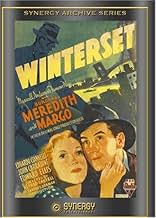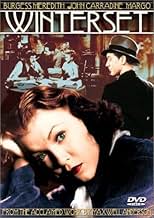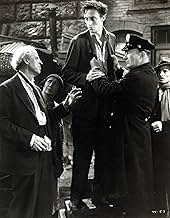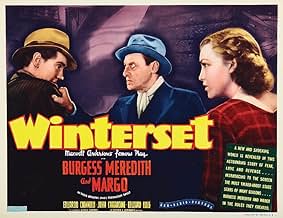Agrega una trama en tu idiomaImmigrant radical Bartolomeo Romagna is falsely condemned and executed for a payroll robbery. Years later, his son Mio sets out to find the truth of the crime and to bring to account the gan... Leer todoImmigrant radical Bartolomeo Romagna is falsely condemned and executed for a payroll robbery. Years later, his son Mio sets out to find the truth of the crime and to bring to account the gangster Trock Estrella.Immigrant radical Bartolomeo Romagna is falsely condemned and executed for a payroll robbery. Years later, his son Mio sets out to find the truth of the crime and to bring to account the gangster Trock Estrella.
- Dirección
- Guionistas
- Elenco
- Nominado a 2 premios Óscar
- 4 premios ganados y 4 nominaciones en total
Murray Alper
- Louie
- (sin créditos)
- Dirección
- Guionistas
- Todo el elenco y el equipo
- Producción, taquilla y más en IMDbPro
Opiniones destacadas
Maxwell Anderson's Pulitzer Prize winning Broadway play was brought to the screen by RKO in 1936 with the original cast members, and Anderson himself adapting the Screen-Play.........The results were a hard-hitting expose' of injustice in the Judicial system of the 1920s........Based loosely on the Sacco-Vancetti trial of the 1920s, Anderson wrote a powerful adaptation of his Stage hit...........Burgess Meredith, along with Eduardo Ciannelli reprised their Stage roles as Mio, and Troc Estrella respectively in their first screen appearences......Both would go on to do scores of films and stage work for decades to come after Critic's raved about their work in "Winterset"......Set under the Brooklyn Bridge for most of the film, the characters involved in the injustice, assemble seeking the truth & to avoid it becoming public knowledge.........Ciannelli's "Troc Estrella" is one of the screens most dastardly bad guys of all time......and Stanley Ridges is a standout as "Shadow' his henchman...............The Musical score by Nathaniel Shilkret & Max Steiner(un-credited) was nominated for an Oscar.......It was so compelling in this Dark-Drama, that Orson Welles used portions of it in his film "Journey Into Fear'-1942....also released by RKO.......If you are a fan of fine Dramatic Acting, superb musical scoring, and very early film noir(1936)....you should see "Winterset.......Tense, Poetic, and spell-binding....It is available on Video and DVD at Amazon.com, for a very low price.......Respectively submitted, sasheegm at the movies
I like this film. It is an interesting retelling of a point of view regarding one of America's most controversial trials - the 1921 - 1927 legal ordeal of Nicolo Sacco and Bartholomeo Vanzetti for the murder of two men in a payroll robbery in Massachusetts. Both were Italian anarchist immigrants in the U.S. Both were convicted by juries which were local Yankee in make-up, not having any non-Yankees on them. Certainly no Italian Americans. The judge, Webster Thayer, was an openly bigoted man. But thousands of people around the country and the world attacked the verdict, and demanded a retrial. Among those who attacked the trial was George Bernard Shaw, Edna St. Vincent Millay, Sinclair Lewis, Fiorello La Guardia, and (in a move that opened his later great judicial career) Felix Frankfurter. After going through appeals, and the revelations of a fellow prisoner that the payroll robbery was committed by a local criminal gang, the matter was left to a small commission headed by President Lowell of Harvard College. It turned out to be a whitewash. In the end, the two men were electrocuted. Thayer's and Lowell's reputations never recovered from this.
Scholars on the case are still divided on the guilt or innocence of the two defendants - some have suggested they were both railroaded, or that Sacco was more likely to be guilty, but Vanzetti was probably innocent. Today, nearly eighty years after their deaths they still remain a flash point regarding American bigotry. In 1977, on the 50th Anniversary of their deaths, Governor Michael Dukakis formally pardoned both men.
Maxwell Anderson wrote about the subject twice: the play WINTERSET and the play HIGH TOR. Anderson's reputation as a dramatist has been inflated over the years by critics like Brooks Atkinson. He could occasionally write a well done play, but he was not on the level of his contemporary Eugene O'Neill. O'Neill's tragedies (especially his final ones) was based on personal demons from his family and his life. O'Neill was also willing to experiment on stage with masks (THE GREAT GOD BROWN) or with internal counter-dialogs (STRANGE INTERLUDE) or even with trilogies based on Greek originals (MOURNING BECOMES ELECTRA). Anderson only experimented one way - he tried blank verse plays (ELIZABETH THE QUEEN, MARY OF Scotland), and did not do it too well. But here he obviously was passionately determined to defend the memory of the two Italian - American anarchists. His plot is based on developing the thread of the confession (mentioned above) that the murders were planned by a local criminal gang. The gang's leader is Eduardo Cianelli, a brutal criminal who framed the two men by stealing their car as the getaway car.
But the strength of the confession is furthered by claiming the judge was bribed (Thayer was biased but not bribed). Edward Ellis (best recalled as the missing inventor in THE THIN MAN) is the corrupt jurist, who is now a wandering derelict. Vanzetti's famous final letter from the death cell (an elegant final comment that is the basis of contention between Henry Fonda and Eugene Palette in THE MALE ANIMAL) is the basis for the elegant denunciation of the judge in the court by John Carridine (note that his character's first name is also Bartholomeo). Ironically, today, it is believed that elegant final message of Vanzetti may have been written in part by a reporter who supported the defendants.
The son and daughter of the dead men (Burgess Meredith and Margo) are seeking to prove their innocence. But they run against the determination of Cianelli, and his goons. The film is fascinating enough, and concludes satisfactorily (much more than the actual case did). The plot's conclusion also leads to a more prosaic point - if you plan to use a signal to destroy someone, don't forget that signal and use it yourself. See the film to understand that last point.
Scholars on the case are still divided on the guilt or innocence of the two defendants - some have suggested they were both railroaded, or that Sacco was more likely to be guilty, but Vanzetti was probably innocent. Today, nearly eighty years after their deaths they still remain a flash point regarding American bigotry. In 1977, on the 50th Anniversary of their deaths, Governor Michael Dukakis formally pardoned both men.
Maxwell Anderson wrote about the subject twice: the play WINTERSET and the play HIGH TOR. Anderson's reputation as a dramatist has been inflated over the years by critics like Brooks Atkinson. He could occasionally write a well done play, but he was not on the level of his contemporary Eugene O'Neill. O'Neill's tragedies (especially his final ones) was based on personal demons from his family and his life. O'Neill was also willing to experiment on stage with masks (THE GREAT GOD BROWN) or with internal counter-dialogs (STRANGE INTERLUDE) or even with trilogies based on Greek originals (MOURNING BECOMES ELECTRA). Anderson only experimented one way - he tried blank verse plays (ELIZABETH THE QUEEN, MARY OF Scotland), and did not do it too well. But here he obviously was passionately determined to defend the memory of the two Italian - American anarchists. His plot is based on developing the thread of the confession (mentioned above) that the murders were planned by a local criminal gang. The gang's leader is Eduardo Cianelli, a brutal criminal who framed the two men by stealing their car as the getaway car.
But the strength of the confession is furthered by claiming the judge was bribed (Thayer was biased but not bribed). Edward Ellis (best recalled as the missing inventor in THE THIN MAN) is the corrupt jurist, who is now a wandering derelict. Vanzetti's famous final letter from the death cell (an elegant final comment that is the basis of contention between Henry Fonda and Eugene Palette in THE MALE ANIMAL) is the basis for the elegant denunciation of the judge in the court by John Carridine (note that his character's first name is also Bartholomeo). Ironically, today, it is believed that elegant final message of Vanzetti may have been written in part by a reporter who supported the defendants.
The son and daughter of the dead men (Burgess Meredith and Margo) are seeking to prove their innocence. But they run against the determination of Cianelli, and his goons. The film is fascinating enough, and concludes satisfactorily (much more than the actual case did). The plot's conclusion also leads to a more prosaic point - if you plan to use a signal to destroy someone, don't forget that signal and use it yourself. See the film to understand that last point.
From RKO studios in 1936 (though it looks as though it were made in the earliest 30s), during the heyday of the Astaire-Rogers musicals, came something rich and strange. Maxwell Anderson's very serious poetic play was boiled down into a movie that's part Depression-era gangster flick, part Shavian social-issue drama, and part neo-Greek tragedy.
The igniting fuse was the Nicola Sacco/Bartolomeo Vanzetti case of 1927, where two immigrant anarchists were condemned (some would say railroaded) to death supposedly for a robbery in which guards were killed. Anderson pushes it back to 1920 and focuses on a single man, Bartolomeo Romagna (John Carradine), whose auto, filled with anarchist/socialist tracts, is stolen for a similar crime by gangster Eduardo Cianelli. When condemned, Carradine eloquently rebukes the judge (Edward Ellis).
The film now flashes forward to 1936, when Romagna's down-and-out drifter son (Burgess Merdith), spurred by revisionist theories of the case, journeys to New York to confront the surviving principals, including Cianelli, Ellis and a reluctant witness (Paul Guildfoyle). All converge for a reckoning preordained by The Fates....
Anderson has heightened his dialogue to lend it immortal aspirations (which may have been a grandiose miscalculation the dominant rhetorical mode of the twentieth century, obvious even by 1936, is flatting). The high-flown posture extends to the look of the film, too a stylized nightscape that's a harbinger of the look of film noir to come a few years later. A low-ceilinged tenement-basement flat is oppressively claustrophobic (markedly so, given the number of actors crammed into it), while the cobblestones and stone arches of the low-rent streets near New York's waterfront glisten wickedly in the pelting rain. (At times the slums look like the central squares of those Transylvanian villages so common in Universal horror pix of this era).
Almost every element of Winterset should seem laughable now but doesn't (though there are a few close shaves). There's an early sequence involving a hurdy-gurdy that lures the slum-dwelling underclass out of its burrows to dance that's hauntingly powerful as is the face of Winterset's love interest, an actress known as Margo, that harks back to the expressiveness of the silents.
The igniting fuse was the Nicola Sacco/Bartolomeo Vanzetti case of 1927, where two immigrant anarchists were condemned (some would say railroaded) to death supposedly for a robbery in which guards were killed. Anderson pushes it back to 1920 and focuses on a single man, Bartolomeo Romagna (John Carradine), whose auto, filled with anarchist/socialist tracts, is stolen for a similar crime by gangster Eduardo Cianelli. When condemned, Carradine eloquently rebukes the judge (Edward Ellis).
The film now flashes forward to 1936, when Romagna's down-and-out drifter son (Burgess Merdith), spurred by revisionist theories of the case, journeys to New York to confront the surviving principals, including Cianelli, Ellis and a reluctant witness (Paul Guildfoyle). All converge for a reckoning preordained by The Fates....
Anderson has heightened his dialogue to lend it immortal aspirations (which may have been a grandiose miscalculation the dominant rhetorical mode of the twentieth century, obvious even by 1936, is flatting). The high-flown posture extends to the look of the film, too a stylized nightscape that's a harbinger of the look of film noir to come a few years later. A low-ceilinged tenement-basement flat is oppressively claustrophobic (markedly so, given the number of actors crammed into it), while the cobblestones and stone arches of the low-rent streets near New York's waterfront glisten wickedly in the pelting rain. (At times the slums look like the central squares of those Transylvanian villages so common in Universal horror pix of this era).
Almost every element of Winterset should seem laughable now but doesn't (though there are a few close shaves). There's an early sequence involving a hurdy-gurdy that lures the slum-dwelling underclass out of its burrows to dance that's hauntingly powerful as is the face of Winterset's love interest, an actress known as Margo, that harks back to the expressiveness of the silents.
Call it Vintage, if you will, but you will not call Winterset boring unless a world of interesting details bore you. The movie is full of sub-stories, full of details that bring back the early days of everyday troubled life for Americans, especially New Yorkers. While not actually typical, the story is one that hangs together.
I suspect the story plot and actor management of the story were perfected on Broadway long before going to film. It is both engaging and fascinating for movie buffs who are students of the perfected B/W film and is a study in filmography which makes one wonder if this is not the height of perfection, if you will, concerning films of that genre: Good story, good delivery and good conclusion.
The story is not one with a tragic ending for the principles. It is not one that builds up the viewer's expectations and hopes and then dashes them in the end. While there are hints of evil and tragedy, the people most deserving receive this end, the ones who deserve the best of the ending actually do get the best in the end.
The organ music is superb for selection and for an almost hypnotic melody that plays on in one's head for some time afterward. A nice, pleasant melody. And on it hangs the turning point in the movie, a grand hook to hang the ending.
The antics of the policeman is what one would expect of one of New York's finest of that era. A masterful job of acting.
Most of all, Margo! She was again engaging, spell-binding and her job well-done. She caused the viewer to want to provide her sympathy from a good and kind father, who was incapable of doing all he could for his children, and to a brother who was caught up in a crime and later regretted it and who endeavored to correct his mistake. Again, superb acting.
Overall, Winterset stands out as one of the most enjoyable movies I have ever watched. I try to share it with friends who have never seen it before. None who see it for the first time have been disappointed.
I suspect the story plot and actor management of the story were perfected on Broadway long before going to film. It is both engaging and fascinating for movie buffs who are students of the perfected B/W film and is a study in filmography which makes one wonder if this is not the height of perfection, if you will, concerning films of that genre: Good story, good delivery and good conclusion.
The story is not one with a tragic ending for the principles. It is not one that builds up the viewer's expectations and hopes and then dashes them in the end. While there are hints of evil and tragedy, the people most deserving receive this end, the ones who deserve the best of the ending actually do get the best in the end.
The organ music is superb for selection and for an almost hypnotic melody that plays on in one's head for some time afterward. A nice, pleasant melody. And on it hangs the turning point in the movie, a grand hook to hang the ending.
The antics of the policeman is what one would expect of one of New York's finest of that era. A masterful job of acting.
Most of all, Margo! She was again engaging, spell-binding and her job well-done. She caused the viewer to want to provide her sympathy from a good and kind father, who was incapable of doing all he could for his children, and to a brother who was caught up in a crime and later regretted it and who endeavored to correct his mistake. Again, superb acting.
Overall, Winterset stands out as one of the most enjoyable movies I have ever watched. I try to share it with friends who have never seen it before. None who see it for the first time have been disappointed.
The drama itself is interesting to watch in this adaptation of Maxwell Anderson's play, and the themes that it brings out include some particularly weighty ones. The solid cast included at least three performers who were continuing their Broadway roles, and while the production does have a stagy feel at times, it often seems rather appropriate to the material.
The brief prologue shows a political extremist (who is presumably also an immigrant) wrongly accused and executed for a murder committed by a holdup gang. The circumstances are similar to those in some notorious real cases of a slightly earlier era, in which politically unpopular persons were railroaded into convictions because of the public's fear of their beliefs.
The main action starts with Burgess Meredith portraying the executed man's son, now an adult, and determined to get to the bottom of the case despite the obstacles that have come with time. In the course of things, he encounters the judge who had presided over his father's trial, a witness with important information, and a brutal crime boss who is determined to prevent the case from being re-opened. The setup produces some good psychological and ethical tensions, in addition to the drama on the surface.
Most of the supporting cast performs well. John Carradine has a brief role as the father, Margo has a good and important role as a young woman torn between family loyalty and her attraction to Meredith's character, and Eduardo Ciannelli believably portrays the soulless, desperate crime boss. Mischa Auer succeeds in a brief, atypical role as a street agitator. But Edward Ellis gives the best performance, as the judge whose conscience has been tormented ever since the fateful case. The characters and the tragic situation that links them are all effectively portrayed.
The brief prologue shows a political extremist (who is presumably also an immigrant) wrongly accused and executed for a murder committed by a holdup gang. The circumstances are similar to those in some notorious real cases of a slightly earlier era, in which politically unpopular persons were railroaded into convictions because of the public's fear of their beliefs.
The main action starts with Burgess Meredith portraying the executed man's son, now an adult, and determined to get to the bottom of the case despite the obstacles that have come with time. In the course of things, he encounters the judge who had presided over his father's trial, a witness with important information, and a brutal crime boss who is determined to prevent the case from being re-opened. The setup produces some good psychological and ethical tensions, in addition to the drama on the surface.
Most of the supporting cast performs well. John Carradine has a brief role as the father, Margo has a good and important role as a young woman torn between family loyalty and her attraction to Meredith's character, and Eduardo Ciannelli believably portrays the soulless, desperate crime boss. Mischa Auer succeeds in a brief, atypical role as a street agitator. But Edward Ellis gives the best performance, as the judge whose conscience has been tormented ever since the fateful case. The characters and the tragic situation that links them are all effectively portrayed.
¿Sabías que…?
- TriviaBurgess Meredith, in his first film with a credited role, recreates the role he played in the original Broadway production.
- ConexionesFeatured in Sprockets: Masters of Menace (1995)
Selecciones populares
Inicia sesión para calificar y agrega a la lista de videos para obtener recomendaciones personalizadas
- How long is Winterset?Con tecnología de Alexa
Detalles
- Fecha de lanzamiento
- País de origen
- Idiomas
- También se conoce como
- Under New Yorks broar
- Locaciones de filmación
- Productora
- Ver más créditos de la compañía en IMDbPro
- Tiempo de ejecución
- 1h 17min(77 min)
- Color
- Relación de aspecto
- 1.37 : 1
Contribuir a esta página
Sugiere una edición o agrega el contenido que falta





































